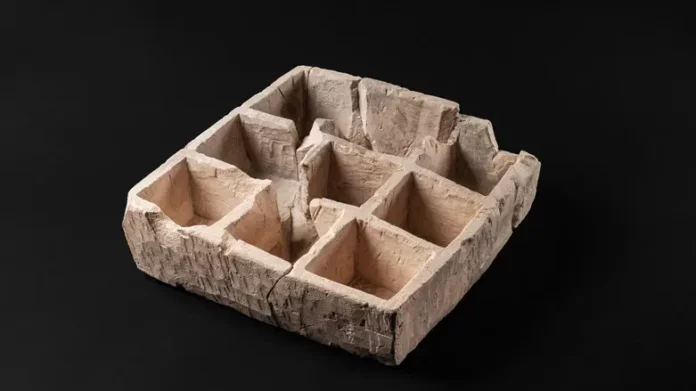JERUSALEM (VINnews) — A rare multi-compartment stone container, dating back to the days of the Second Temple – about 2,000 years ago – was revealed to the public on Wednesday for the first time at the Israel Museum in Jerusalem.
Join our WhatsApp groupSubscribe to our Daily Roundup Email
The unusual and rare box was discovered during excavations conducted by the Israel Antiquities in the City of David, funded by the City of David Foundation in conjunction with the Ministry of Heritage.
The square box, measuring 30 x 30 cm, was carved from soft limestone and divided inside into nine equal sized compartments. The multi-compartment container was discovered in a destruction layer inside an ancient store which dates to the end of the Second Temple period. The store once stood alongside the Pilgrimage Road leading from the City of David to Temple Mount. The sides of the box are blackened, indicating that is was burnt, perhaps during events of the Great Jewish Revolt, which ultimately led to the destruction of Jerusalem.
Researchers assume that the box was used for commercial purposes such as displaying premeasured goods. According to Dr. Yuval Baruch and Ari Levy, excavation directors on behalf of the Israel Antiquities Authority, “During the excavations of the Pilgrimage Road where the box was discovered, many objects have been found testifying to the flourishing commercial activity that took place alongside the road during the Second Temple period.”
“The excavations uncovered ceramic and glass vessels, production and cooking facilities, various measuring tools, stone weights and coins. Together, these objects suggest that the road was connected to commercial activities such as a lively urban market. The Pilgrimage Road connecting the Pool of Siloam to the Temple Mount was the main thoroughfare of the city 2,000 years ago. It seems that the newly-discovered compartment box was related to this commercial activity that took place along the Pilgrimage Road.”
The economic and commercial systems of Second Temple Jerusalem were similar to other large cities in the Roman world and boasted large markets featuring local and imported goods, some even exotic. As a temple city and pilgrim center, ancient Jerusalem’s markets must have had specialized items not commonly found in other areas.
Daily life and trade in Second Temple Jerusalem involved strict adherence to Jewish purity laws. Evidence of this can be seen by a number of stone-based archaeological finds such as thousands of limestone vessel fragments discovered in excavations throughout the ancient city and its surroundings. The widespread use of stone vessels can be explained by Jewish law (halakha) which designates that stone, unlike made clay or metal, cannot become impure. Therefore, it is possible that stone vessels were reused over and over for long periods of time.
“It seems that the multi-compartment stone box from the City of David was related to the unique Jerusalem economy conducted in the shadow of the Temple maintaining strict observance and in accordance with purity laws. Therefore, we can consider this box a distinctly Jerusalem find.” Levy and Dr. Baruch say. [It is also safe to assume that the box held items like food which could become impure if not held within a pure container]
Pieces of another similar box were discovered about 50 years ago by the archaeologist Nachman Avigad during excavations in the Jewish Quarter. Upon discovery, Avigad humorously called the object a “nuts and seeds bowl,” a name which has stuck since. Interestingly, all similar boxes have been discovered in Jerusalem, mostly in the City of David. However, the newly-discovered box is the only complete example. At this stage of research, archaeologists still wonder what exactly it was used for.
According to Dudi Mevorah, senior curator of the Archaeology Department at the Israel Museum in Jerusalem, “The box was found broken into pieces with parts missing. The fragments were brought to Victor Uziel, conservationist from the Israel Museum Artifact Conservation Laboratory, which specializes in treatment and restoration of artifacts directly from the field. We placed the stone box on permanent display together with spectacular colorful frescos, chandeliers, and magnificent pottery, stone, and metal vessels from Jerusalem’s luxury houses dating to the end of the Second Temple period.”


That was candy gift box for Shabbos hosts.
The first coffee cup carrier tray! I’m sure the people building the Bais Hamikdash needed a coffee break!
So does this prove that the Palestinians were here first?
Straight out of a mishnah in Keilim 2:7- see mishnayos with pictures!
Obviously for holding baseball cards, organized by team or player position. (They didn’t have the DH back then)
There are nine items in the ketoress. Maybe,the box was used to store those ingredients?
First Tic-Tac-Toe game board.
Oh, so they sold eggs by the dozen back then too?